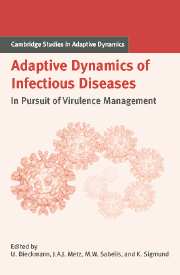Book contents
- Frontmatter
- Contents
- Contributing Authors
- List of Boxes
- Notational Standards
- 1 Introduction
- A Setting the Stage
- B Host Population Structure
- C Within-Host Interactions
- D Pathogen–Host Coevolution
- E Multilevel Selection
- F Vaccines and Drugs
- Introduction to Part F
- 23 Managing Antibiotic Resistance: What Models Tell Us?
- 24 Evolution of Vaccine-resistant Strains of Infectious Agents
- 25 Pathogen Evolution: The Case of Malaria
- 26 Vaccination and Serotype Replacement
- G Perspectives for Virulence Management
- References
- Index
- International Institute for Applied Systems Analysis
25 - Pathogen Evolution: The Case of Malaria
Published online by Cambridge University Press: 15 January 2010
- Frontmatter
- Contents
- Contributing Authors
- List of Boxes
- Notational Standards
- 1 Introduction
- A Setting the Stage
- B Host Population Structure
- C Within-Host Interactions
- D Pathogen–Host Coevolution
- E Multilevel Selection
- F Vaccines and Drugs
- Introduction to Part F
- 23 Managing Antibiotic Resistance: What Models Tell Us?
- 24 Evolution of Vaccine-resistant Strains of Infectious Agents
- 25 Pathogen Evolution: The Case of Malaria
- 26 Vaccination and Serotype Replacement
- G Perspectives for Virulence Management
- References
- Index
- International Institute for Applied Systems Analysis
Summary
Introduction
The rapid development of molecular methods for use in epidemiological studies has led to the accumulation of vast amounts of data on pathogen diversity. Whether or not the observed diversity is relevant to the management of virulence depends on the functional status of the polymorphic elements, either as factors of virulence or in the fundamental processes that underlie the population dynamics of these systems. In this chapter, we focus on antigenic diversity in pathogen populations, and its implications for virulence management.
To understand how antigenic diversity has evolved, it is first necessary to develop a reasonable system of classification. The term “strain” used widely to designate different parasite types. In the case of certain pathogens that do not exchange genetic material, the term “strain” is synonymous with “clone” (Maynard Smith et al. 1993). However, whether they are clonal or not, pathogens may be usefully classified into strains with respect to a certain set of relevant markers. For example, the population may be divided into drug-resistant and drug-susceptible strains on the basis of their response to a particular chemotherapeutic agent. This response may be determined by variation at a single locus or a combination of genetic loci. Similarly, a pathogen population may be categorized into antigenic types with respect to variation at a set of genetic loci encoding these antigens. When these antigens induce immune responses that have an effect on the transmission success of the pathogens, the associated antigenic types, or strains, may be seen as epidemiological units.
- Type
- Chapter
- Information
- Adaptive Dynamics of Infectious DiseasesIn Pursuit of Virulence Management, pp. 347 - 361Publisher: Cambridge University PressPrint publication year: 2002
- 1
- Cited by



